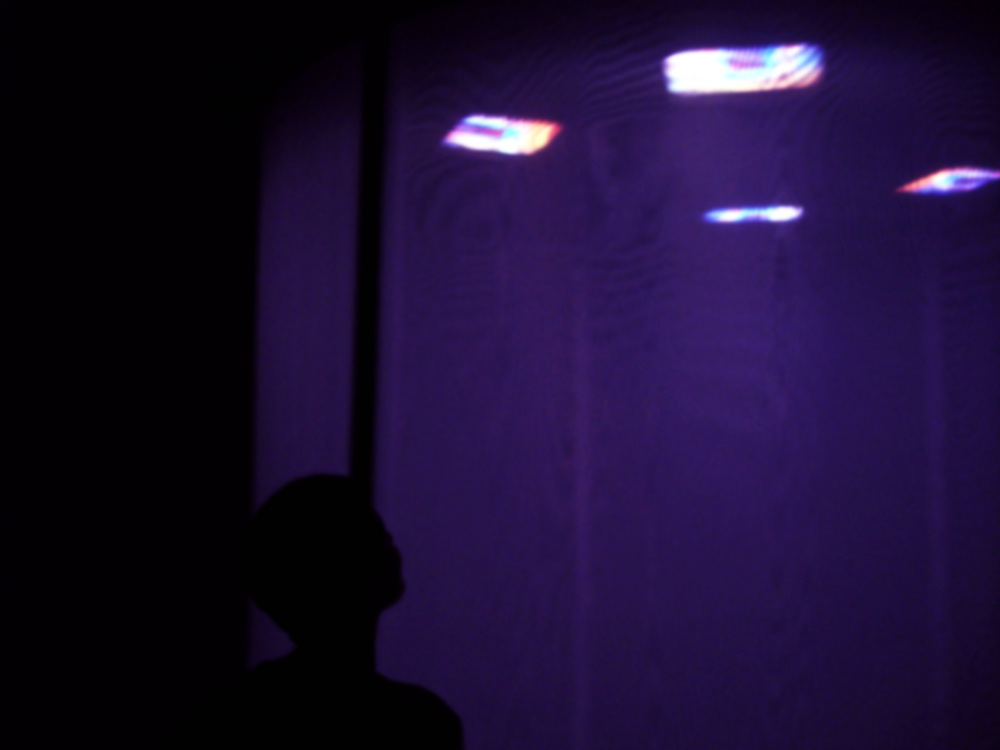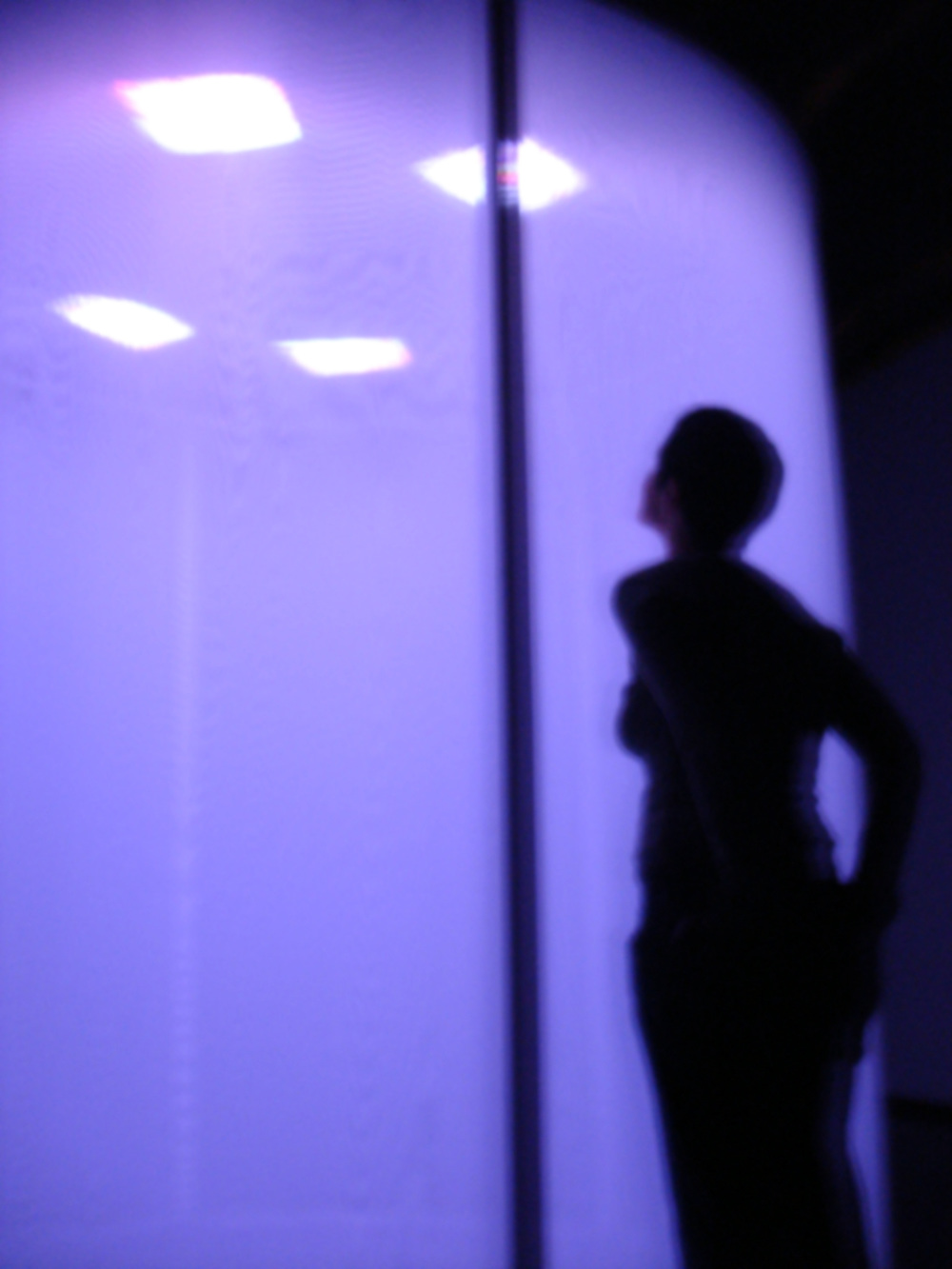

Perceptible Simulacrum
Wood, fabric, and 4 TV monitors
244 x 244 x 305 cm (approx.)
96 x 96 x 120 in (approx.)
Rio de Janeiro, 2006
Perceptible Simulacrum was shown at Prêmio Projéteis exhibition in Funarte, in 2006, after Gustavo Prado was presented with a national award for the arts, by the same institution, which is connected directly to the Brazilian Ministry of Culture.
This installation consisted of a few different elements in comparison to the rest of the series. It was the first to use a cylinder shape, and it was the first to use TV monitors instead of lamps as a light source. It also didn’t have a previous programmed combination of colors, what it did instead was to appropriate four of the most watched channels as an arbitrary source of light color, to filter the images contained in it, and to accumulate the light projection in order to reveal it incessantly to the viewer.
Wood, fabric, and 4 TV monitors
244 x 244 x 305 cm (approx.)
96 x 96 x 120 in (approx.)
Rio de Janeiro, 2006
Perceptible Simulacrum was shown at Prêmio Projéteis exhibition in Funarte, in 2006, after Gustavo Prado was presented with a national award for the arts, by the same institution, which is connected directly to the Brazilian Ministry of Culture.
This installation consisted of a few different elements in comparison to the rest of the series. It was the first to use a cylinder shape, and it was the first to use TV monitors instead of lamps as a light source. It also didn’t have a previous programmed combination of colors, what it did instead was to appropriate four of the most watched channels as an arbitrary source of light color, to filter the images contained in it, and to accumulate the light projection in order to reveal it incessantly to the viewer.
Created over the course of 10 years (between 2002 and 2011), the Perceptible series followed and reflected significant changes in Gustavo Prado’s work, particularly regarding the viewer’s perception and the relationship between the artwork and space. Perceptible Sundial (2002) is the first work in the series and is presented as a cube (considered one of the simplest forms for human recognition), made with a wooden structure and covered with fabric and paper. Its relatively simple form becomes complex in its interaction with space (and time). Aspects such as the place where it is positioned, and the natural light that shines upon it (which changes throughout the day and from one day to the next), influence characteristics such as viewing angles, transparency, opacity, and shadows, making the perception of this work broad, varied, and almost unpredictable. It functions as a constant exercise in the viewer’s perception and the possibility of presence within space.
The following works in the series increasingly emphasize the installation dimension, expanding their scale in built environments with colored fluorescent lamps, fabrics, metal structures, presence sensors, and monitors. These are environments in which viewers are invited to be present, where external interferences are suspended, giving way to conditions of experimentation created and controlled by the artist, such as the use of color and the intensity of lighting, which directly affect the perception of space. Perceptible 8 (2005), for example, reproduces the form of Perceptible Sundial on an enlarged scale and, instead of relying on the sun, uses a set of lamps connected to the structure of the environment and presence sensors to shape the lighting of the space.
In the final works of the Perceptible series, the artist and the viewer engage with everyday space, outside the control and predictability of institutional spaces. This is the case with works like Perceptible Heraclitus River (2006). In this piece, a geometric structure was installed in different locations along a river in the city of Itaipava (a mountainous region of Rio de Janeiro). Over the course of 30 days, these situations were documented in photographs and videos, later edited into images that construct different perceptions from the presence of this object in a natural setting.
As a whole, the works in the Perceptible series draw attention to reality understood as a construction, always in progress—open, in process, and shaped by individual, political, social, and economic variables.
The following works in the series increasingly emphasize the installation dimension, expanding their scale in built environments with colored fluorescent lamps, fabrics, metal structures, presence sensors, and monitors. These are environments in which viewers are invited to be present, where external interferences are suspended, giving way to conditions of experimentation created and controlled by the artist, such as the use of color and the intensity of lighting, which directly affect the perception of space. Perceptible 8 (2005), for example, reproduces the form of Perceptible Sundial on an enlarged scale and, instead of relying on the sun, uses a set of lamps connected to the structure of the environment and presence sensors to shape the lighting of the space.
In the final works of the Perceptible series, the artist and the viewer engage with everyday space, outside the control and predictability of institutional spaces. This is the case with works like Perceptible Heraclitus River (2006). In this piece, a geometric structure was installed in different locations along a river in the city of Itaipava (a mountainous region of Rio de Janeiro). Over the course of 30 days, these situations were documented in photographs and videos, later edited into images that construct different perceptions from the presence of this object in a natural setting.
As a whole, the works in the Perceptible series draw attention to reality understood as a construction, always in progress—open, in process, and shaped by individual, political, social, and economic variables.




